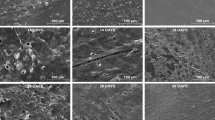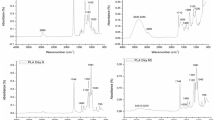Abstract
Mineralization percentages of ground starch-based films are similar (68–72%), whatever the degradation medium and the norm used, with standard deviations less than 8%. Vermiculite, an inert solid medium, shows an intermediary behaviour, between liquid and compost media. Consequently, this support is suitable for further degradation studies, including the determination of carbon balances.
Similar content being viewed by others
References
American Standard ASTM D-5209–92 (1994) Standard test method for determining the aerobic biodegradation of plastic materials in the presence of municipal sludge. In: Annual Book of ASTM Standards, Vol. 8.03. Philadelphia, PA, pp. 372–375.
American Standard ASTM D-5338–92 (1994) Standard test method for determining the aerobic biodegradation of plastic materials under controlled composting conditions. In: Annual Book of ASTM Standards, Vol. 8.03. Philadelphia, PA, pp. 439–443.
Degli-Innocenti F, Tosin M, Bastioli C (1998) Evaluation of the biodegradation of starch and cellulose under controlled composting conditions. J. Environ. Polym. Degrad. 6: 197–202.
European Packaging Directive (1994) Directive 94/62/EC of the European parliament and the council on packaging and packaging waste. European Union.
European Standard CEN WI 261 085 (draft) (1997) Evaluation of the ultimate aerobic biodegradability and disintegration of packaging material under controlled composting conditions (method by analysis of released carbon dioxide).
European Standard CEN WI 261 218 (draft) (1998) Evaluation of the ultimate aerobic biodegradability of plastic materials in an aqueous medium (method by analysis of released carbon dioxide).
Onteniente JP, Fontaine C, Meuret C, Prudhomme JC (1997) Techniques de mise en forme de nouveaux matériaux biofragmentables. Matériaux et techniques 3–4: 1–26.
Otey FH, Westhoff RP, Russell CR (1977) Biodegradable films from starch and ethylene-acrylic acid copolymer. Ind. Eng. Chem., Prod. Res. Dev. 16: 305–308.
Pagga U, Beimborn DB, Boelens J, De Wilde B (1995) Determination of the aerobic biodegradability of polymeric material in a laboratory controlled composting test. Chemosphere 31: 447–4487.
Pranamuda H, Tokiwa Y (1999) Degradation of poly(L-lactide) by strains belonging to genus Amycolatopsis. Biotechnol. Lett. 21: 901–905.
Spitzer B, Menner M (1996) Simulation of a compost environment in a mono-substrate fixed-bed system. DECHEMA Monographs 133: 681–689.
Starnecker A, Menner M (1996) Assessment of biodegradability of plastics under simulated composting conditions in a laboratory test system. Intl. Biodeter. Biodegrad. 7: 85–92.
Author information
Authors and Affiliations
Rights and permissions
About this article
Cite this article
Gattin, R., Poulet, C., Copinet, A. et al. Comparison of mineralization of starch in liquid, inert solid and compost media according to ASTM and CEN norms for the composting of packaging materials. Biotechnology Letters 22, 1471–1475 (2000). https://doi.org/10.1023/A:1005679813855
Issue Date:
DOI: https://doi.org/10.1023/A:1005679813855




